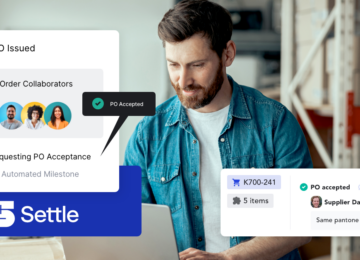As your business evolves and grows, so does your operations’ intricacy. The same holds true for your purchase order (PO) management process, where a once straightforward task becomes more complex as the number of POs you must create, track, and manage amplifies.
As a result, there’s an urgent need for a more robust and adaptable purchase order management strategy. In this guide, we’ll simplify creating and managing purchase orders for your growing brand. From adopting supply chain automation to implementing scalable frameworks, we’ll explore the key elements that empower you to streamline your purchase order process.
Why Effective Purchase Order Management Matters
Your purchase order management strategy plays a direct role in the success of your brand. Effective PO (purchase order) management shapes the health of your entire procurement process and influences your ability to get products into the hands of your customers.
Let’s break down why brands, especially those on a growth trajectory, should prioritize a well-managed PO system.
- Scalability and Efficiency: A well-managed PO system provides a scalable framework that streamlines the procurement process, ensuring that as transaction volumes increase with business growth, operations remain efficient and well-coordinated.
This is why automation is a crucial component of a growing PO process. Automation reduces manual effort, minimizes the risk of errors and allows teams to focus on strategic aspects of the business rather than getting bogged down by administrative tasks.
- Financial Accuracy and Control: A robust PO system helps maintain financial discipline by enforcing budgetary controls. This is crucial for growing brands that need to allocate resources judiciously and avoid overspending.
By requiring approval workflows within the PO system, businesses can prevent unauthorized purchases, mitigating the risk of unnecessary expenditures.
- Transparency and Accountability: A well-managed PO system provides transparency into the procurement process, offering stakeholders clear visibility into transaction details, order status, and associated costs. This transparency fosters trust and collaboration.
Clearly defined roles and responsibilities within PO management also ensure accountability at every stage of the procurement journey. This is particularly crucial as your brand grows, preventing bottlenecks and reducing the likelihood of errors.
- Supplier Relationships: Efficient PO management facilitates smoother collaboration between buyers and suppliers. Clear documentation and communication through purchase orders contribute to stronger and more fruitful supplier relationships.
A well-managed PO system also helps you negotiate better terms with suppliers, leveraging a structured procurement process to optimize costs and terms.
- Smarter Decision Making: A robust PO process generates valuable data that brands can analyze for insights into purchasing patterns, supplier performance, and overall procurement efficiency.
Your supply chain team can make informed decisions based on this data derived, enabling strategic planning and continuous improvement in procurement processes.
Navigating Purchase Order Challenges Amidst Growth
Many brands are scaling into new channels to capitalize on growing consumer demand. Brand growth introduces complexities that demand careful navigation to ensure the sustained efficiency and effectiveness of purchase order processes. These include:
- Increased Transaction Volumes: One of the primary challenges businesses face during growth is the surge in transaction volume. As the number of orders escalates, manual tracking and processing become impractical and prone to errors. Scaling up without a corresponding enhancement in PO management systems can lead to delays, inaccuracies, and a loss of operational control.
- Expanding Supplier Network: Business expansion often entails diversifying the supplier network to meet growing demands. Managing relationships with an increasing number of suppliers becomes challenging, requiring a more sophisticated approach to communication, collaboration, and coordination. Without a structured PO system, the risk of miscommunication and delayed deliveries rises substantially.
- Rise in Risk of Errors: Reliance on manual processes becomes a vulnerability as your brand grows. Manual data entry, approval workflows, and tracking leave room for human errors. Such errors can cascade throughout the procurement process, impacting order accuracy, delivery timelines, and financial accountability.
- Inefficient Approval Workflows: As the number of purchase orders increases, inefficient approval workflows can lead to bottlenecks. Delays in approvals can result in delayed shipments and strained relationships with suppliers. An effective PO management system must facilitate swift and structured approval processes to maintain operational flow.
- Difficulty in Tracking and Reporting: Growth introduces a multitude of data points related to procurement. Without an organized system for tracking and reporting, you may find it challenging to derive meaningful insights from the data. A lack of analytical capabilities can hinder strategic decision-making and process optimization.
How to Create and Manage Purchase Orders: A Step-by-Step Guide
Step 1: Define Your Purchase Order Process
Begin by outlining a clear and standardized PO creation process. Define the stages, from requisition to approval, and establish protocols for order documentation. This foundational step sets the stage for consistency and clarity in your procurement workflow.
Step 2: Gather Necessary Information
Collect all essential information before creating a PO. This includes the supplier’s name and contact information, item descriptions, quantities, agreed-upon prices, delivery schedules, and any specific terms or conditions. Ensuring comprehensive information upfront minimizes errors in subsequent stages.
Step 3: Utilize Purchase Order Software
Explore and implement purchase order software to automate and streamline the entire procurement process. PO software offers a multitude of benefits, including the ability to automate tasks such as order creation, approval workflows, and tracking. Your brand can experience heightened efficiency, reduced manual errors, and faster transaction processing.
You can manage your entire PO process with one tool, using Anvyl’s supply chain visibility platform. This negates the need to shuffle between email, spreadsheets, and other tools to create and track your POs, a problem that’s long plagued brands.
Since adopting Anvyl, men’s fashion brand Trendhim saves 780 hours annually managing POs. This allows them to create, track, and manage 62% more purchase orders and, consequently, meet more demand for their products.
To learn more about the benefits of purchase order software, check out our blog here.
Step 4: Input Information into the Purchase Order
Enter the gathered information into the purchase order template or software. Double-check for accuracy, ensuring all details align with the agreed-upon terms and conditions. This step lays the foundation for a transparent and error-free procurement process.
Step 5: Establish Approval Workflows
Institute clear and efficient approval workflows within your organization. Define roles and responsibilities for approval at various stages of the procurement process. Streamlining approvals prevents delays, enhances accountability, and maintains the integrity of the purchasing system.
Pro tip: Use Anvyl’s Custom Workflows to quickly plan, manage and advance purchase order approvals. To learn more about our Custom Workflows, click here.
Step 6: Communicate With Suppliers
Once the PO is approved, communicate the order to the supplier promptly. Using your PO software, you can establish open channels for communication, confirming order details, delivery schedules, and any additional requirements. Clear and transparent communication fosters positive relationships with suppliers.
Step 7: Monitor Order Status and Delivery
Use your PO software to monitor the status of your purchase orders. Track deliveries, confirm receipt of goods or services, and promptly address any discrepancies.
Proactive monitoring via your purchase order solution ensures the procurement process remains on track and aligned with organizational needs. With end-to-end visibility and stronger supplier relationships, Fig.1 Beauty experienced a 53% decrease in PO revisions after adopting our supply chain visibility software.
Step 8: Archive and Organize Purchase Order Records
It’s crucial to maintain a systematic archive of all purchase orders for future reference and auditing purposes. Your purchase order software will do this for you, centralizing your records for easy retrieval. Proper record-keeping enhances transparency and aids in compliance.
Step 9: Analyze Data for Process Improvement
Regularly analyze data generated through the purchase order process. Evaluate key performance indicators (KPIs), identify patterns, and derive insights to optimize your procurement processes continually. Data analysis contributes to informed decision-making and ongoing process improvement.
Interesting in learning how Anvyl’s Supply Chain Visibility Platform can simplify and automate your purchase order process? Contact our sales team today to book a free demo.



